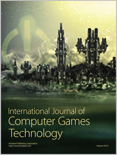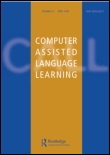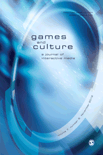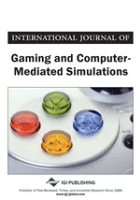
International Journal of Computer Games Technology
Scope & Guideline
Bridging Academia and Practice in Gaming
Introduction
Aims and Scopes
- Game Design and Development:
The journal emphasizes research on the design and development of games, including serious games, educational games, and therapeutic applications, showcasing methodologies that enhance player engagement and learning outcomes. - Player Interaction and Engagement:
A core focus is on understanding player behavior, motivations, and engagement strategies, particularly how game mechanics can influence players' intentions, such as continued play and purchasing decisions. - Technology Integration in Gaming:
The journal explores the integration of advanced technologies like virtual reality, cloud computing, and artificial intelligence in gaming, investigating their applications in enhancing user experience and gameplay. - Social Impact and Educational Applications:
Research on the role of video games in social change, education, and health is prominent, reflecting the journal's commitment to studying games as tools for awareness, attitude change, and skill development. - Game Analytics and Modeling:
The journal includes studies that employ data analytics and modeling techniques to understand game dynamics, player behavior, and to optimize game design through empirical research.
Trending and Emerging
- Serious Games and Gamification:
There is an increasing focus on serious games and gamification strategies, particularly in educational and therapeutic contexts, showcasing their effectiveness in enhancing learning and behavior change. - AI and Machine Learning Applications:
Emerging research on the use of artificial intelligence and machine learning in game development, particularly for enhancing player experiences and automating game design processes, is gaining traction. - Impact of Virtual and Augmented Reality:
The exploration of virtual and augmented reality technologies in gaming is on the rise, reflecting their growing importance in creating immersive experiences and their applications in various fields such as education and healthcare. - Social and Behavioral Impacts of Gaming:
Research examining the social implications of gaming, including its effects on behavior, social change, and community engagement, is trending, indicating a deeper exploration of gaming's role in society. - Data-Driven Game Design:
There is a notable increase in studies utilizing player analytics and data modeling to inform game design decisions, reflecting a shift towards evidence-based approaches in game development.
Declining or Waning
- Traditional Game Mechanics:
Research centered around traditional game mechanics and gameplay paradigms has decreased, suggesting a shift towards more innovative and technology-driven approaches in game design. - General Usability Studies:
While usability remains important, specific studies focusing solely on general usability heuristics without ties to innovative game technologies or player engagement strategies are less frequently published. - Physical Fitness in Gaming:
Although physical fitness related to gaming, such as exergames, was once a prominent topic, recent publications indicate a waning interest as the focus shifts to more psychological and social aspects of gaming.
Similar Journals

Journal of Dynamics and Games
Integrating Theory and Practice for a Dynamic FutureJournal of Dynamics and Games is a premier publication dedicated to advancing the fields of Applied Mathematics, Modeling and Simulation, and Statistics and Probability. Published by the American Institute of Mathematical Sciences (AIMS), this journal serves as a critical platform for researchers, professionals, and students to disseminate innovative theoretical findings and practical applications. With an ISSN of 2164-6066 and an E-ISSN of 2164-6074, it has gained recognition within its field, currently positioned in the Q3 quartile across various categories according to the latest evaluations from 2023. This multidisciplinary journal, running from 2014 to 2024, allows for a rich exchange of ideas and promotes the integration of mathematical theories in complex dynamical systems and games. Although it does not offer an open access option, its rigorous peer-review process ensures high-quality research papers, fostering an academic environment conducive to innovation and collaboration.

Computers
Advancing the Frontiers of Computer ScienceComputers is a leading journal published by MDPI, dedicated to advancing research in the fields of computer networks and communications, as well as human-computer interaction. Since its inception in 2012, it has established itself as a vital resource for scholars and practitioners, achieving an impressive Q2 ranking in Computer Networks and Communications and a Q3 ranking in Human-Computer Interaction as of 2023. The journal is indexed in Scopus, highlighting its relevance with a rank of #135/395 and #72/145 in their respective categories. Published in Switzerland, this open-access journal ensures widespread dissemination of research findings, supporting the global academic community in enhancing technologies relevant to computer science. Access options are available, fostering an environment where knowledge is shared freely. With an emphasis on innovation, redesign, and collaboration between humans and technology, Computers plays a crucial role in shaping the future of digital interactions.

VIRTUAL REALITY
Unlocking New Realities Through Cutting-Edge ResearchVIRTUAL REALITY is a prestigious journal published by SPRINGER LONDON LTD that has been at the forefront of the field since its inception in 1995. This journal, with an ISSN of 1359-4338 and E-ISSN 1434-9957, serves as an indispensable resource for researchers, professionals, and students interested in the rapidly evolving domains of computer graphics, human-computer interaction, and software development. VIRTUAL REALITY holds an impressive Q1 ranking across relevant categories, reflecting its high impact within the academic community, with specific rankings such as 11th overall in Computer Graphics and Computer-Aided Design and 31st in Human-Computer Interaction. This journal aims to publish cutting-edge research that explores theoretical advancements and practical applications related to virtual environments, contributing significantly to knowledge and innovation. With access options available through institutional subscriptions, it continues to shape the landscape of its field and inspire future research in immersive technologies.

Computer Assisted Language Learning
Connecting Technology and Linguistics for Enhanced LearningComputer Assisted Language Learning is a prestigious journal dedicated to the interdisciplinary field of language education technology, published by Routledge Journals, Taylor & Francis Ltd. With its ISSN 0958-8221 and E-ISSN 1744-3210, the journal has become a cornerstone for researchers and practitioners interested in the innovative integration of computer technology in language learning processes. As of 2023, it holds an impressive impact factor, ranking Q1 in both Computer Science Applications and Linguistics and Language categories, indicating its significance within these scholarly domains. The journal covers a wide array of subjects, including language acquisition, educational technology, and instructional design, facilitating an understanding of how digital tools can enhance language learning experiences. Its rigorous editorial standards ensure that published articles undergo thorough peer review, making it a highly respected platform for disseminating cutting-edge research. With an extensive publication history dating back to 1990 and an ongoing commitment to exploring the dynamics of language learning in digital contexts, this journal is essential for academics, educators, and students alike who are looking to stay at the forefront of research in computer-assisted language education.

Games and Culture
Connecting Worlds: Where Gaming Meets CultureGames and Culture is a premier interdisciplinary journal published by SAGE Publications Inc, focusing on the rich intersection of gaming, culture, and society. With an ISSN of 1555-4120 and an E-ISSN of 1555-4139, this esteemed journal facilitates critical discussions and innovative research contributions in fields ranging from anthropology and communication to applied psychology and cultural studies. Its exceptional standing is reflected in its various Scopus rankings, placing it in the 99th percentile for Cultural Studies and the 98th percentile for Anthropology, among others. Covering research from its inception in 2006 through 2024, Games and Culture is devoted to advancing the understanding of how games influence cultural expressions and vice versa, making it an invaluable resource for academics, practitioners, and students alike. While the journal is not open access, its comprehensive scope and high-impact findings ensure that it remains a crucial platform for scholarly exchange and discovery in understanding the increasingly significant role of gaming in contemporary culture.

International Journal of Gaming and Computer-Mediated Simulations
Pioneering Insights into Gaming and SocietyThe International Journal of Gaming and Computer-Mediated Simulations, published by IGI Global, serves as a pivotal platform for the dissemination of cutting-edge research in the realms of gaming and computer-mediated interactions. Established in 2009, it has consistently provided a scholarly space for innovative discussions around the implications, advancements, and societal impacts of gaming technologies and simulations. With an impressive impact factor as it continues to grow within the Q3 category of Computer Science Applications, this journal ranks #491 out of 817 in Scopus, highlighting its significance within an evolving discipline. Featuring contributions from both established and emerging scholars, the journal aims to bridge theoretical knowledge and practical application, thereby nourishing the academic pursuits of researchers, practitioners, and students alike. Access to the journal's rich content is critical for those striving to keep pace in this dynamic field, making it an essential resource for anyone invested in the future of gaming and computer-mediated environments.

BEHAVIOUR & INFORMATION TECHNOLOGY
Innovating Insights into Technology's Impact on Society.BEHAVIOUR & INFORMATION TECHNOLOGY, published by Taylor & Francis Ltd, is a leading journal in the interdisciplinary field that bridges the gap between technology and human behavior. Established in 1982 and continuing through 2024, this journal has garnered a high reputation with impressive rankings in 2023 across various categories: Q1 in Arts and Humanities (miscellaneous), Q2 in Developmental and Educational Psychology, Q2 in Human-Computer Interaction, and Q1 in Social Sciences (miscellaneous). The journal's robust Scopus rankings point to its influence among peers, being placed in the top percentiles across multiple relevant disciplines. Although it does not offer open access, it remains a pivotal resource for researchers and practitioners interested in the dynamics of technology's impact on behavior. By publishing rigorously peer-reviewed research, BEHAVIOUR & INFORMATION TECHNOLOGY aims to foster insights that enhance our understanding of how information technology shapes human interactions and societal outcomes, making it a crucial publication for anyone engaged in this rapidly evolving field.

Advances in Human-Computer Interaction
Pioneering advancements in user experience and design.Advances in Human-Computer Interaction is a premier peer-reviewed journal published by HINDAWI LTD, dedicated to the exploration of cutting-edge research and innovation in the field of Human-Computer Interaction (HCI). With an ISSN of 1687-5893 and an E-ISSN of 1687-5907, this Open Access journal has been contributing to the scientific community since 2008, offering unrestricted access to critical findings and advancements. Based in Egypt with an address at ADAM HOUSE, 3RD FLR, 1 FITZROY SQ, LONDON W1T 5HF, ENGLAND, it occupies a notable position in the academic landscape, reflected in its 2023 Scopus ranking of Rank #57/145 and a 61st percentile in the Human-Computer Interaction category. As a Q3 journal, it plays a crucial role in disseminating research that bridges the gap between humans and technology, providing valuable insights for researchers, professionals, and students pursuing expertise in this dynamic field. The journal’s converged years from 2010 to 2024 signify its ongoing commitment to advancing knowledge and fostering collaboration among HCI experts worldwide.

Games for Health Journal
Pioneering research at the crossroads of gaming and health.Games for Health Journal, published by MARY ANN LIEBERT, INC, is a pioneering journal at the intersection of gaming technology and health, dedicated to advancing the understanding of how digital games can influence health outcomes. Since its inception in 2012 and continuing through 2024, this highly regarded journal has established itself as an essential resource, achieving impressive rankings in a variety of categories—specifically, Q1 in both Health (Social Science) and Rehabilitation, and Q2 in Computer Science Applications and Public Health. Accessibility to cutting-edge research is facilitated through its current Scopus rank, which places it among the top tiers of its field, ensuring it is a vital tool for researchers, professionals, and students keen on exploring innovative approaches to health through gaming. Moreover, the absence of Open Access underscores the journal's commitment to rigorous peer-reviewed content, ensuring high-quality contributions from experts across disciplines. By bridging technology and health, Games for Health Journal stands at the forefront of shaping health-related gaming research, guiding future innovations and applications in the ever-evolving landscape of health solutions.

JOURNAL OF COMPUTER SCIENCE AND TECHNOLOGY
Driving Excellence in Computer Science ResearchJOURNAL OF COMPUTER SCIENCE AND TECHNOLOGY, published by Springer Singapore Pte Ltd, is a pivotal platform in the rapidly evolving realms of computer science and technology. With an ISSN of 1000-9000 and an E-ISSN of 1860-4749, this journal encompasses a diverse array of topics including computational theory, hardware and architecture, software engineering, and applications of computer science. Spanning over three decades from 1986 to 2024, it boasts an impressive standing within academic circles, ranking in the Q2 quartile across several key categories and achieving notable placement in Scopus metrics. Although this journal operates under a subscription-based model, it remains a crucial resource for researchers, professionals, and students seeking to advance their knowledge and contribute to discussions in computer science. The JOURNAL OF COMPUTER SCIENCE AND TECHNOLOGY is committed to fostering innovation and scholarly communication in the field, encouraging submissions that contribute substantive advancements in theory and application.